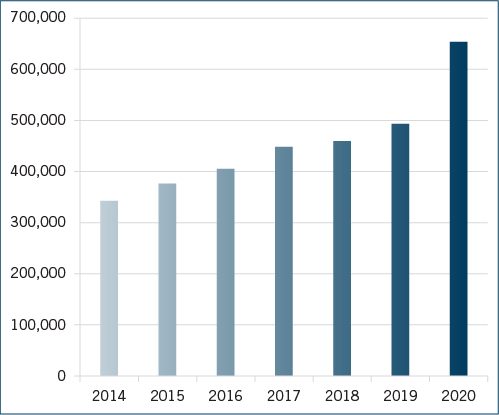2021 Trends in Trademarks
Big challenges in clearing new brands
- U.S. trademark applications skyrocket
- China accounts for 25 percent of U.S. filings
- Fraudulent applications abound
“Are We Running Out of Trademarks?”
The authors of a Harvard Law Review article posed this provocative question, crunched a monumental amount of data, and decided that the answer is “yes.” Marketers are “increasingly resorting to second-best, less competitively effective marks” because of “severe” levels of trademark congestion and depletion, concluded New York University School of Law professors Barton Beebe and Jeanne Fromer.

Their warning rang true when their article first appeared three years ago, because new U.S. trademark applications had just experienced a massive increase, jumping from 400,000 in 2016 to 450,000 in calendar year 2017. Now, the chimes are ringing more loudly – although the 2020 U.S. economy was beset by pandemic woes, trademark applications last year skyrocketed by a stunning one-third, increasing to 659,000 from the previous all-time high of 495,000 in 2019.
Glenn Gundersen, author of the book Trademark Searching, and Chair of Dechert’s Trademark and Copyright Practice, keeps a close eye on trademark filing trends. The volume of new filings influences the chances that an attorney can say “yes” when a client asks whether a new brand name is available. The current surge in applications increases the likelihood that a marketer will be disappointed by a “no” answer when a trademark search shows that its desired mark is already taken. Companies may find themselves settling more often for second or third choices when christening new products.
What caused the 2020 explosion in new filings? A buoyant U.S. economy is one factor. Trademark applications have historically tracked the ups and downs of the marketplace. Marketers create new brand names, logos, and slogans when they are optimistic about the consumer appetite for new products and services, and they throttle back when the market turns from bull to bear. Most notably, in the turn-of-the-century internet bubble, new filings peaked in March 2000, the same month that the NASDAQ average hit its high. In the Great Recession, the September 2008 collapse of Lehman Brothers was followed by a 14 percent tumble in fourth quarter applications compared with the previous year.
In 2020, however, optimistic U.S. companies launching new brands were not the sole motivator in trademark growth – China was an even bigger factor. Almost two-thirds of the increase came from applicants with a PRC address, accounting for 100,000 more filings last year than in 2019. All told, China-based applicants represented a quarter of total applicants for U.S. registration in 2020, up from 11 percent in 2017, and just two percent in 2014.
A Hot Market Hinders Trademark Clearance
2020 caps a decade in which total U.S. trademark applications more than doubled, from a calendar year 2011 baseline of 309,000. As a result, the clearance process has become more time-consuming and expensive. Trademark lawyers must spend more time reviewing and evaluating the growing volume of marks, resulting in lengthier search opinions with more complicated legal analyses. If a client’s first choice washes out after all that effort, it must start the process again with a new candidate mark, and repeat until it finds an available brand.
The U.S. Patent and Trademark Office provides a free search database to assist in finding prior conflicting marks, but many companies and law firms rely on commercial search firms to conduct clearance searches. These firms have traditionally employed analysts who search for marks that could be considered confusingly similar to a candidate mark. More recently, these firms have introduced artificial intelligence-driven tools, with algorithms replacing human searchers. The aim is to save money and speed the delivery of search results, but artificial intelligence is sometimes outsmarted by the quirky creativity of U.S. branding. Many trademarks incorporate plays-on-words, puns, and deliberate misspellings, but they still could be considered confusingly similar to the conventional dictionary spelling. Finding these unexpected variants has always been a trademark search challenge, going back to such invented 1890s marks as UNEEDA BISCUIT. Computers can be programmed to search for common variations on spellings, but cannot yet match the intuition of a trained human searcher in ferreting out marks that may have little visual resemblance to a conventional spelling, but have the same pronunciation or meaning.
A similar problem limits the effective application of AI to design trademarks. New search tools rely on image recognition to compare a company’s desired logotype against the existing universe of designs, looking for similar shapes and features. However, these tools can be hit-or-miss, because the human eye interprets an image differently than a computer does, and can make visual connections that the computer misses.
Understanding the China Syndrome
The good news is that trademark congestion is not quite as dire as the astronomical 2020 filing numbers suggest, because American marketers would have no interest in many of the marks that Chinese applicants are seeking. Many of these marks consist of unpronounceable strings of letters (for example, FCEDAUS, SUPWVSC, RLENOIUML and HGTIDSXE); others are coined terms that are definitely not mellifluous (YUTEMOPLE, NANGELRN, AEERGURED). Some Chinese applicants in 2020 simply took strings of adjacent letters right off the keyboard, filing for QWERTYU, YUIOP, ASDFG, ASDFGH, ASDFGHJKL, HJKL, ZXCVB and ZXCVBNM.
The number of applications from China fluctuates wildly from month to month, presumably making it very difficult for the Trademark Office to plan workload. Two-thirds of the 2020 applications were filed in the last four months of the year.
The influx of applications by Chinese nationals is driven in part by government financial incentives. The U.S. Trademark Office said in January that “China has reportedly adopted more than 70 subnational trademark subsidy measures, including measures for domestic and foreign applications and registrations.” It reported “a surge in fraudulent trademark applications originating in China” after Shenzhen and other cities began offering subsidies for U.S. applications that exceeded the cost of filing. Observers speculated that some applicants were filing solely for the financial benefits.
However, the author of last year’s New York Times story, “All Your Favorite Brands, From BSTOEM to ZGGCD”, offered another explanation, concluding that “Amazon is causing us to drown in trademarks.” John Herrman reported that Chinese entities accounted for almost half of Amazon’s top U.S. sellers, and observed that a U.S. trademark registration is a prerequisite to taking advantage of Amazon’s Brand Registry, creating an incentive for offshore vendors to apply. He cited the proliferation in online retail of such bizarre marks as NERTPOW, JOYOLDELF, PVENDOR, MAJCF, BINECSIES and BSTOEM, finding that the inherent appeal of a mark seemed irrelevant to a Chinese merchant’s success in selling on Amazon.
Adopting a random-consonant, vowel-free, gibberish mark is a quick and efficient way to obtain a U.S. trademark registration, because it minimizes the chances that registration will be blocked by a prior registrant’s similar mark. Few, if any, U.S. marketers would want something similar. For example, the mark ZXCVB, taken directly from the lower-left-hand corner of the keyboard, registered in less than five months. Our AI search tool confirmed the wisdom of the applicant’s strategy – it retrieved only six marks that it rated as “similar” to ZXCVB, all filed by other Chinese applicants – SZXC, ZXXC, ZXZXING, ZXGHYQ, ZXLN, and ZXREEK. In contrast, searching a mark composed of conventional English dictionary words on the same database typically yields 100 to 400 marks that it rates as “similar.”
Many of the China-based applicants submitted evidence of U.S. trademark use that was obviously false – a notorious example being an application to register INSTAMARKET for retail stores, supported by a doctored image of a Walmart store. In a November 2020 Columbia Law Review Forum article, Professors Beebe and Fromer found that fraudulent specimens accompanied 70 percent of use-based applications originating in China filed in 2017, that the Trademark Office approved 60% of the fraudulent applications, and that almost 40 percent ultimately registered. They calculated that 14 percent of all applications filed that year were fraudulent, “worsen[ing] the problems of trademark depletion and clutter.” The Office has since instituted more stringent measures to detect bogus claims of use.
Finding Room in a Crowded House
Branding gridlock stems not just from new applications, but from the surfeit of older marks that are still registered, a number that has grown as applications increased throughout the decade. An existing registration will block an application for a new similar mark, even if the registrant has abandoned the prior mark. The register is replete with “deadwood” registrations of marks not used in years.
The U.S. “use it or lose it” system prevents trademark owners from holding onto trademark rights indefinitely. A registrant loses its registration unless it files proof of continued use with the Trademark Office by the sixth, tenth, and successive ten-year anniversaries of registration. However, when the Trademark Office began a pilot program auditing these maintenance filings for accuracy in 2012, 50 percent of the audited registrants could not actually document the accuracy of their claims of continued use. Faced with the startling fact that half of registrants were making either careless or dishonest maintenance filings (notwithstanding the under-penalty-of-perjury declaration), the Office made the audit program permanent in 2017, and has since increased the number of registrations audited. It has now also created financial penalties for fixing inaccuracies made in maintenance filings. However, the continuing audits still show that half the audited registrants were not actually using their marks on all the goods and services claimed in their maintenance filings.
The Trademark Modernization Act enacted in late December provides new ammunition for brand owners to clear the register of prior applicants who falsely obtained registration, and to clean out deadwood registrations. However, the most significant tool won’t become available until this coming December – a new type of action allowing anyone to challenge a registration on the basis of non-use. A party will be able to seek expungement of a trademark registered at least three years, on the basis that the mark has never been used in commerce for some or all of the identified goods and services. In addition, re-examination proceedings will target registrations no more than five years old on the grounds that the marks were not used for some or all of the identified goods as of certain key dates in the application process – most notably the filing date of an application claiming use in commerce. These tools could ease the clearance of new trademarks, affording a quicker and less expensive way to verify that old registered marks are indeed deadwood, and remove them as obstacles. However, only marketers with a longer brand-choice timelines will find the new proceedings useful. Companies that need to select a new mark in a rush won’t have enough time to wait for the results of an action.
In their big data dive into the U.S. trademark register, Professors Beebe and Fromer put the scarcity into numbers. At the time of their study:
- 97 percent of the 86,408 most frequently-used English-language words matched an active 2016 trademark registration.
- Only 187 of the 1,000-most-used English-language words had not been registered, as of 2016. These included such less desirable words as PROBLEM, VIOLENCE, DEAD and DISEASE.
Since then, applicants have snapped up such previously unwanted one-word marks such as ALONG, ANY, BEGINNING, BEHIND, BELOW, CERTAINLY, COMING, DECIDED, EARLY, LACK, NEEDED, PERHAPS, PRACTICE, SHORT, SOMETIME, and WAYS.
Beebe and Fromer also identified the 20 single-word marks that appeared most frequently in applications filed from 1985 to 2014. Not surprisingly, some of these, like EXTREME, ELITE, and ADVANTAGE are very commonplace. Others are more distinctive on their face, but could very well disappoint marketers who select them, because of the high likelihood that they either won’t be available, or will blend into the commercial wallpaper. All of these continue to rank high in a current check of active U.S. applications and registrations of one-word marks.
- TITAN appears by itself without other wording in over 250 active applications and registrations.
- ECLIPSE, GENESIS, FUSION, GUARDIAN, and APEX each appears as a standalone mark in more than 200 active applications and registrations.
- IMPACT, QUANTUM, INFINITY, OASIS, ENCORE, REVOLUTION, SPECTRUM, ELITE, and INSIGHT each appears in more than 150.
If new trademarks are hard to come by, .COM domain names are incredibly scarce. If a company wants a .COM domain to match a conventionally-spelled new mark, it has no choice but to buy the domain from the current holder. As of the time of their study, Professors Beebe and Fromer found that the following had already been registered as .COM domains:
- All possible domains consisting of combinations of two letters.
- All but 36 of the 17,576 possible three-letter combinations.
- 99.7 percent of the 456,976 possible four-letter combinations.
- 89.5 percent of the 86,408 most frequently-used words in American English.
- 99.5 percent of the 151,671 surnames listed in U.S. Census data, representing more than 90 percent of U.S. population.
Mrktrs Wrk Arnd Grdlck
For many years, the scarcity of conventional .COM domain names had a significant influence on branding choices. Companies coined entirely new marks, combined dictionary words in novel ways, or deliberately misspelled words, because these unique variants had not yet been taken as domains.
Today, a matching .COM is no longer an essential accessory to a new brand. Multiple other top-level domains have been created and are available. Moreover, consumers rely on search engines to find desired sites, rather than hunting for their desired destination by coupling a mark with .COM.
Still, the sheer difficulty of finding available new marks causes marketers to look outside the box of dictionary words:
- Web sites such as TUMBLR and FLICKR have accustomed consumers to marks that omit a final vowel. 2020 filings in this vein included FLAVR (for beverages), HINDR (protective coatings), CENTR and GATHR (social networking), GOOBR (social networking for pets), and CONQR (one for music streaming, another for sunscreen).
- Some branders are more audacious in challenging consumers’ deciphering skills – they misspell words while also subtracting vowels. Examples included FYNDR (advertising), MEUZM (art), BSCLY (wardrobe basics), and the social networking services RAPCHR and CTRLFREQ.
- Since the public often reacts negatively to wholly-coined new marks, one solution is to craft an original brand name that feels like a dictionary word. The ersatz adverb has appeal to many companies. The 2020 initial public offering of READLY, the digital magazine subscription service, may have inspired similarly derived marks in which –LY is pinned to the end of a word that describes or suggests the product. Applications included ADVENTURELY (for travel and tourism), APPLIANCELY (appliance installation and repair), BEANLY (coffee), CARBONLY (emissions offset analysis), EDITLY (video software), GREENDLY (reusable water bottles), GROOVLY (music), PHUNDLY (microfinance lending), PRINTLY (printing), ROAMLY (cellular service), TOTELY (luggage), ZIPLY (shipping), and POOPLY (bowel health).
Expletives Deleted
The Supreme Court’s 2019 decision striking down the prohibition on U.S. registration of “immoral” and “scandalous” trademarks did not open the floodgates for new applications for bad words. Most notably, 2020 filings did not increase for marks that include some form or variation of the word beginning with “f”. Some were more cranky than creative, merely following “F…” with terms such as COVID, CANCER, RACISM, and MONDAYS. Others were more imaginative evocations of the word, including EFFIN DELICIOUS (cooking classes), FLUFF YEAH (sheepskin sandals), GET THE FORK OUTTA HERE (a food truck), MOTHER FLUFFER (false eyelashes), ZROFKSGVN (clothing), and FLUSTERCLUX (podcasts on “our toxic achievement culture”). Three filings likely captured most people’s feelings about the year – each simply followed some form of “F…” with “2020.”



